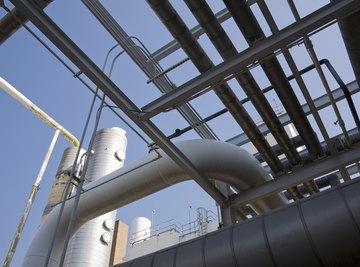
Cleaning up wastewater from communities and industries eliminates or reduces pathogenic bacteria and toxic chemicals, and provides a palatable water source for human and agricultural uses. Biological wastewater treatment uses bacteria and other microorganisms to decompose organic contaminants, meaning carbon-containing substances, into harmless or volatile compounds. Biological treatment usually follows the removal of large debris or solids from wastewater. Some microbes already reside in wastewater; the addition of "activated sludge", containing more microbes, increases the efficiency of decomposition. Wastewater facilities use aerobic, anaerobic or both types of microbes. The pros and cons of biological treatments depend partly on the origin of wastewater and its type of contamination and applied methods. Some methods, such as membrane filtration, subsequent to biological treatment, may improve outcomes.
What Are Aerobic and Anaerobic Treatments?
Aerobic microbes require oxygen and organic nutrients to work and grow. Nutrients are provided by the organic material in wastewater and oxygen is usually delivered by pumping air into the treatment tank. The end products of aerobic digestion are energy, carbon dioxide and metabolized solids that settle out. The nutrients and oxygen cause aerobic microbes to multiply and their increased number speeds up the digestion process.
Anaerobic microbes are bacteria and microorganisms that function in the absence of oxygen. These microbes break down organic contaminants more slowly than aerobic microbes. Anaerobic microbes produce methane, carbon dioxide and more anaerobic microbes. Wastewater, which contains a high level of organic contaminants, is more efficiently treated with anaerobic microbes before undergoing treatment with aerobic microbes.
Pros of Aerobic Digestion
Aerobic wastewater treatment is a rapid and efficient process removing at least 98 percent of organic contaminants. It is a natural oxidation process that causes efficient breakdown of organic pollutants and yields a cleaner water effluent than anaerobic treatment alone. Because aerobic digestion is a fast process it can handle larger volumes or in-flows of wastewater.
Cons of Aerobic Digestion
Aerobic digestion requires aeration, which uses a large amount of electrical energy. Electrical energy is often generated by burning of fossil fuels, which produce greenhouse gases. Aerobic digestion also results in large amounts of bio-solids, or sludge, which require disposal. Inappropriate release of the nutrient-rich sludge into rivers or ponds can cause algae overgrowth, or eutrophication, which kills fish and other aquatic life. Energy consumption and excess sludge production can be reduced by treating wastewater first with anaerobic microbes. Although biological wastewater treatment is efficient in removing most organic contaminants, studies indicate that some chemicals, such as pharmaceuticals, detergents, cosmetic and industrial compounds, still remain after biological wastewater treatment. Filters and new technologies may be able to address this problem.
Pros of Anaerobic Digestion
Anaerobic waste water treatment is more environmentally friendly than aerobic digestion, because it produces less biomass, requires less energy and produces a bio-gas (methane) that can be recycled. Although both aerobic and anaerobic treatments produce carbon dioxide during breakdown of bio-contaminants, aerobic digestion generates far less gas. Anaerobic digestion also produces fewer bio-solids, which can present a disposal problem.
Cons of Anaerobic Digestion
Although anaerobic digestion of contaminants in wastewater leaves a smaller carbon footprint, it is a slow process. It is less efficient than aerobic digestion, removing 70 to 95 percent of organic contaminants. Anaerobic microbes, compared to aerobic microbes, attack a smaller range of contaminants.
References
About the Author
Based in Connecticut, Marie-Luise Blue writes a local gardening column and has been published in "Organic Gardening" and "Back Home." Blue has a Ph.D. in biological sciences from the State University of New York at Stony Brook and wrote scientific articles for almost 20 years before starting to write gardening articles in 2004.
Photo Credits
Thinkstock Images/Comstock/Getty Images
